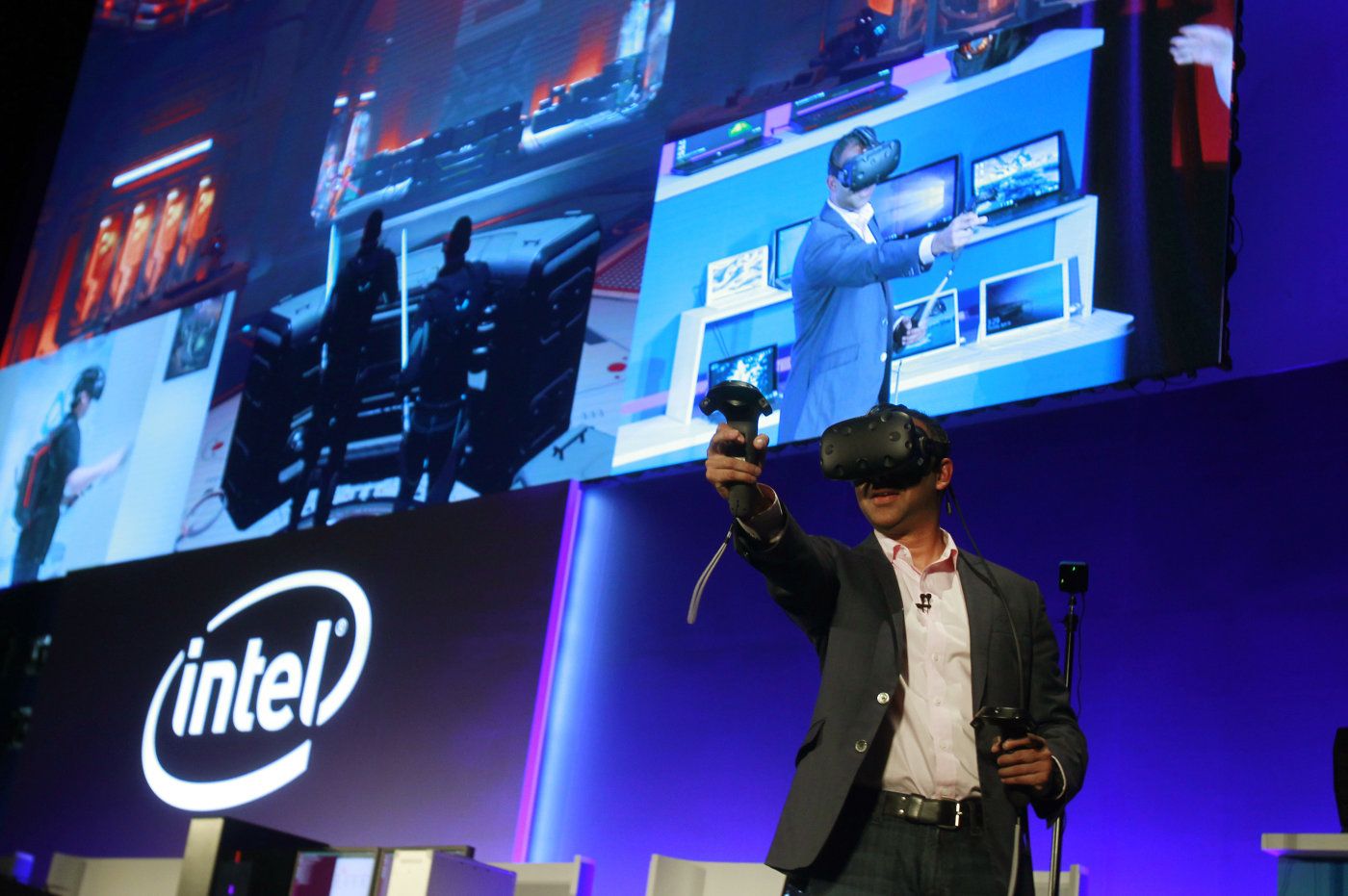Very true points by Kharam.
At SC Congress Toronto, Evgeniy Kharam, director and network security solutions architect at Herjavec Group predicted that the future network security was in machine learning, quantum computing and the cloud.


Intel is in the midst of its biggest business transition ever. Just a few months ago, the chip giant announced that it would be laying off 11,000 workers and taking a step away from the PC market. Instead, it’ll be focusing on wearables and IoT devices. Coinciding with those announcements was an executive shuffle that put Navin Shenoy, its Mobile Client VP, in charge of its wider Client Computing Group (which covers all consumer devices). At Computex this week, we had a chance to pick Shenoy’s brain about Intel’s path forward.
What do you envision being the next major breakthrough for PC form factor?
We’re working on lots of things that are mind-blowing. To me, we have to figure out how to get to J.A.R.V.I.S. [Iron Man’s trusty AI, not Intel’s vaporware earpiece]. The ability to manipulate things wherever you are, look at things wherever you are, talk to things in a more natural way. That’s the next big breakthrough in computing. And it will be in so many domains, it won’t just be PCs. It’ll be phones, tablets and also new types of things we haven’t conceived of yet.

Another reliable article on the Quantum Internet work.
You can’t sign up for the quantum internet just yet, but researchers have reported a major experimental milestone towards building a global quantum network — and it’s happening in space.
With a network that carries information in the quantum properties of single particles, you can create secure keys for secret messaging and potentially connect powerful quantum computers in the future. But scientists think you will need equipment in space to get global reach.
Researchers from the National University of Singapore (NUS) and the University of Strathclyde, UK, have become the first to test in orbit technology for satellite-based quantum network nodes.

Earlier this spring, Russian billionaire Yuri Milner casually announced his intention to develop spacecraft that can travel at up to 20 percent the speed of light and reach Alpha Centauri within twenty years. From the outset, it was clear that no humans would be making the warp jump—the mission will involve extremely lightweight robotic spacecraft. A new fleet of tiny satellites hints at what those future interstellar voyagers will look like and be capable of.
Meet Sprites: sticky note-sized devices that sure look like the result of the Pentagon’s long-anticipated floppy disk purge, but are in fact state-of-the-art spacecraft complete with solar cells, a radio transceiver, and a tiny computer. Later this summer, a Cornell-led project called Kicksat-2 will launch 100 of these puppies to the International Space Station. There, the satellites will spend a few days field-testing their navigational hardware and communications systems before burning up in orbit.
The project’s lead engineers, Zachary Manchester and Mason Peck, are on the advisory committee for Breakthrough Starshot, an ambitious effort to reach our nearest neighboring star system within a generation. (In fact, the potato chip-sized computer Milner held up during a highly publicized press conference in April was Manchester’s own design.) Sprites, and the “chipsat” technology they’re based on, are a step toward that goal of interstellar travel. More generally, they’re an indication of the future of space exploration.

Excellent story; glad that this bank in Australia is getting prepared for Quantum now instead of later which will be too late for some. Good news is that Wall Street as well as the US Government are getting educated on Quantum Computing. I do hope more and more businesses and institutions start developing their own internal QC expertise so that they are prepared for the switch that is coming across all industries.
The Commonwealth Bank’s decision to contribute millions of dollars to quantum computing research is not just about the significant commercial potential of the technology itself but also about developing its own in-house expertise in the area, according to chief information officer David Whiteing.
The bank last year committed to contributing $10 million over five years to UNSW’s Centre for Quantum Computation and Communication Technology (CQC2T). That was in addition to $5 million it announced in December 2014 that it would put towards the centre.
(Telstra last year announced it would also invest $10 million in the centre. The government’s $1.1b Innovation Agenda included $26 million for UNSW’s quantum computing research efforts.)

Scientists at Ludwig-Maximilians-Universitaet (LMU) in Munich and the Max Planck Institute for Quantum Optics (MPQ) have devised a new interferometer to probe the geometry of band structures.
The geometry and topology of electronic states in solids play a central role in a wide range of modern condensed-matter systems, including graphene and topological insulators. However, experimentally accessing this information has proven to be challenging, especially when the bands are not well isolated from one another. As reported by Tracy Li et al. in last week’s issue of Science (Science, May 27, 2016, DOI: 10.1126/science.aad5812), an international team of researchers led by Professor Immanuel Bloch and Dr. Ulrich Schneider at LMU Munich and the Max Planck Institute of Quantum Optics has devised a straightforward method with which to probe band geometry using ultracold atoms in an optical lattice. Their method, which combines the controlled transport of atoms through the energy bands with atom interferometry, is an important step in the endeavor to investigate geometric and topological phenomena in synthetic band structures.
A wide array of fundamental issues in condensed-matter physics, such as why some materials are insulators while others are metals, can be understood simply by examining the energies of the material’s constituent electrons. Indeed, band theory, which describes these electron energies, was one of the earliest triumphs of quantum mechanics, and has driven many of the technological advances of our time, from the computer chips in our laptops to the liquid-crystal displays on our smartphones. We now know, however, that traditional band theory is incomplete.

When I 1st read this headline, I had to pause and ask myself “was the article’s author informed at all on QC?” especially given China’s own efforts much less D-Wave, Google, and University of Sydney. And, then I read the article and I still have to wonder if the author is on top of the emerging technologies such as BMI, graphene, QC, and other nanotechnology that are already being tested to go live in the next 7 to 10 years plus much of the content is very superficial at best. I am glad that the author did put the tid bit on Singularity as the endpoint state; however, that is pretty well known. Nonetheles, sharing to let you be the judge.
For decades, we relied on silicon as the semiconductor for our computer chips. But now, working at nanometer scales, it looks like physical limitations may end the current methods to include more and more processing power onto each individual chip.
Many companies are making billion-dollar investments to continue scaling down semiconductor technology. The pressures of big data and cloud computing are pushing the limits of the current semiconductor technology in terms of bandwidth, memory, processing speed, and device power consumption.
Today’s state-of-the-art silicon chips are engineered at the 22- and 14-nanometer scale. Research is underway to take that down to 10-nanometer scale in the next several years.

Storage in your laptop or smartphone is a compromise between volume, access speed and physical size. But, the industry’s competition to shrink them while boosting their specifications is fierce. A few months after shipping a 16TB solid-state drive, Samsung has announced a fast, efficient 512GB SSD that’s half the size of a postage stamp.
Samsung’s press release claims that the drive is the first mass-produced 512GB SSD with non-volatile memory express (NVMe), a host-controller interface with a streamlined register for speed, in a single package. Unlike other hard drives in multi-chip packages (MCP), Samsung’s new drive is organized in a ball grid array into a collected unit, making it simpler to fit in and connect to other parts in the device. This makes the drive ideal for the ultra-slim notebook PC market, where space and weight are at a premium.
A senior Samsung VP said in a press release that the tiny drive triples the performance of a typical SATA SSD. Its read/write speeds of up to 1,500MB/s and 900MB/s, respectively, mean you could transfer a 5GB HD video in 3 seconds. Samsung will start selling the drive in June in 512GB, 256GB and 128GB models.

Researchers used high-purity graphene and observed for the first time that its charged particles behave like fluid with relativistic properties. This discovery holds promise for thermoelectric devices as well as for studying the behavior of black holes and celestial bodies.
( Peter Allen/Harvard SEAS )
Electrons in graphene appear for the first time to behave like a liquid, potentially leading to devices that can efficiently convert heat to electricity and chips that can precisely model the behavior of black holes and high-energy celestial objects.
Since it was discovered 10 years ago, graphene has been hailed as a wonder material: extremely light, strong, hard and among the most conductive items on Earth. The challenge, however, is studying the unique properties of this one-atom-thick material.

With huge leaps taking place in the world of artificial intelligence (AI), right now, experts have started asking questions about the new forms of protection we might need against the formidable smarts and potential dangers of computers and robots of the near future.
But do robots need protection from us too? As the ‘minds’ of machines evolve ever closer to something that’s hard to tell apart from human intelligence, new generations of technology may need to be afforded the kinds of moral and legal protections we usually think of as ‘human’ rights, says mathematician Marcus du Sautoy from the University of Oxford in the UK.
Du Sautoy thinks that once the sophistication of computer thinking reaches a level basically akin to human consciousness, it’s our duty to look after the welfare of machines, much as we do that of people.